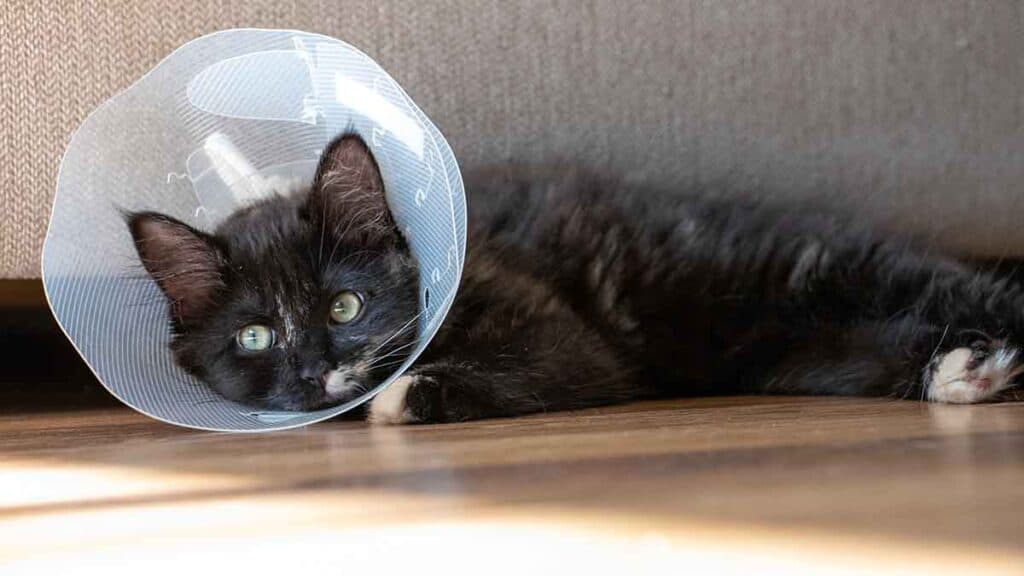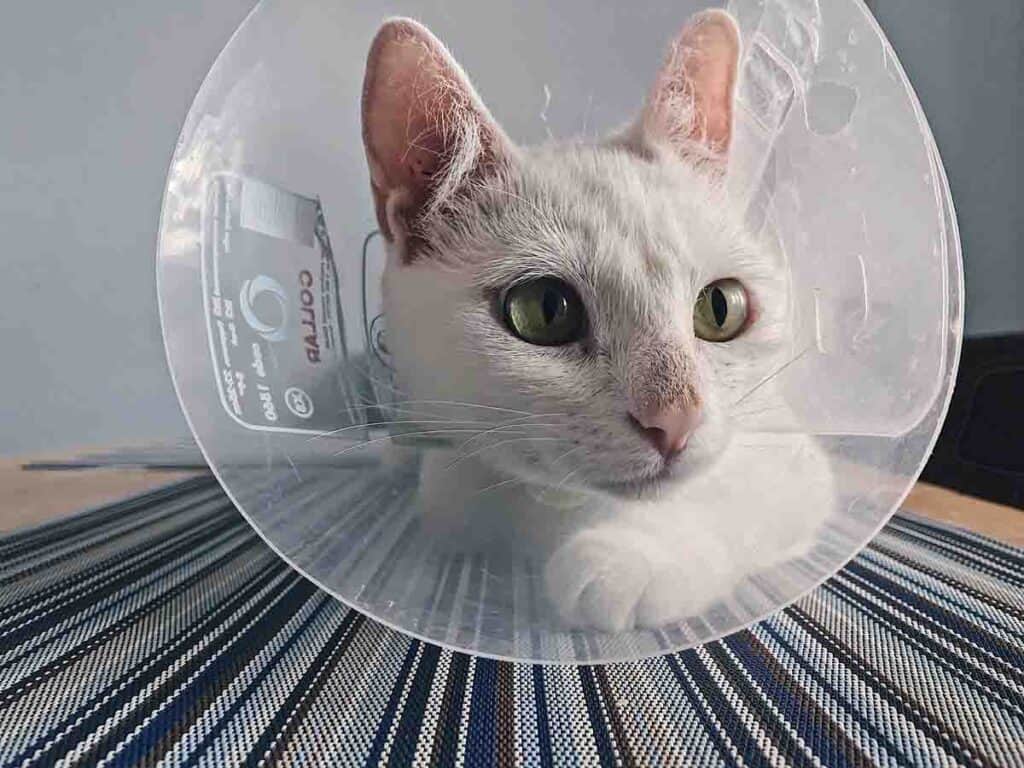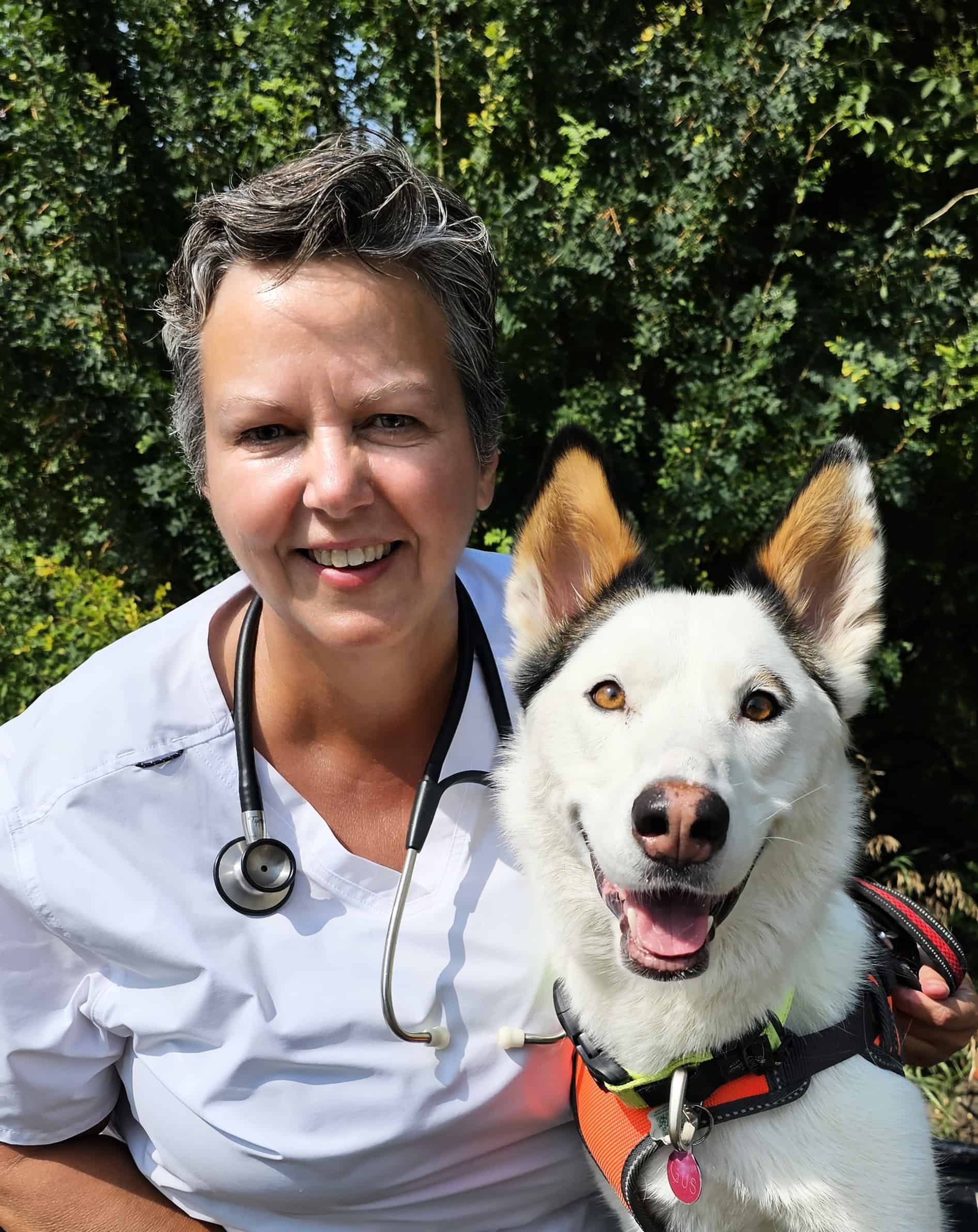Has your veterinarian told you that your cat is going to need an Elizabethan collar, or e-collar? If so, you are probably wondering what exactly your vet is talking about.
An Elizabethan collar for cats is a cone-shaped device that fastens around the cat’s neck and prevents them from licking or scratching areas of the body they should not. It is used when a cat needs to heal from an injury or surgery, or has a medical condition that requires medication or treatment.
In this article we will explain what an Elizabethan collar is and answer questions that you may have about them. So let’s dive in and discover more about how these cone-shaped devices work to protect your cat’s health and what alternatives are available.
What Is An Elizabethan Collar For Cats?
An Elizabethan collar for cats, also known as an E-collar or a cone, is a protective device that is placed around a cat’s neck to stop them from being able to lick or bite any part of their body. It is named after the large, ruffled collars that were popular during the Elizabethan era.
The collar is usually made of plastic or a similar material and has a cone-shaped design that extends out from the cat’s head. It is secured around the cat’s neck with adjustable straps or Velcro.
When Are Elizabethan Collars Used For Cats?
Elizabethan collars for cats are typically used when we need to stop a cat from licking, biting, or scratching a wound, injury, or surgical incision.
This is important because cats have a natural instinct to groom and clean themselves, but excessive licking or biting can damage the affected area and delay healing. Additionally, if a cat has stitches or a wound, they may try to scratch it which can cause further harm and increase the risk of infection.
Common scenarios where a cat may need an Elizabethan collar include:
- Surgical procedures: If your cat has had surgery, your veterinarian may recommend an Elizabethan collar to prevent them from licking or biting at the incision site.
- Skin conditions: Cats with skin conditions such as allergies, rashes, or hot spots may excessively lick or bite at affected areas, causing further irritation or infection.
- Wound or injury: If your cat has a wound or injury, an Elizabethan collar can prevent them from scratching or biting at the area and allow it to heal properly.
Overall, Elizabethan collars are used to protect cats from harming themselves while they recover from an injury or surgery, or while they are undergoing treatment for a medical condition.
Are There Different Kinds Of Elizabethan Collars For Cats?
Elizabethan collars come in various sizes and shapes to fit different cat breeds, and there are different designs that cater to different needs.
Here are some common types of Elizabethan collars for cats:
Traditional Cone-Shaped Plastic Collars: These are the most common type of Elizabethan collars for cats and are shaped like a cone that extends out from the cat’s head. They come in different sizes to fit different cat breeds and are made of a durable plastic material.
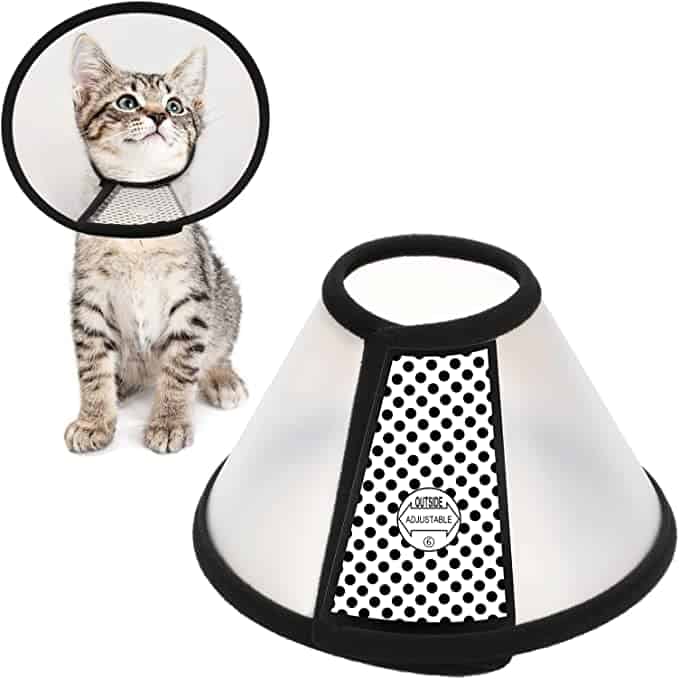
Soft Elizabethan Collars: These collars are made of a soft, pliable material like foam or fabric and are designed to be more comfortable for cats to wear. As they are more flexible than the traditional plastic cone, it may be possible for a very determined cat to find a way to bend it enough to lick or bite at some areas of their body.
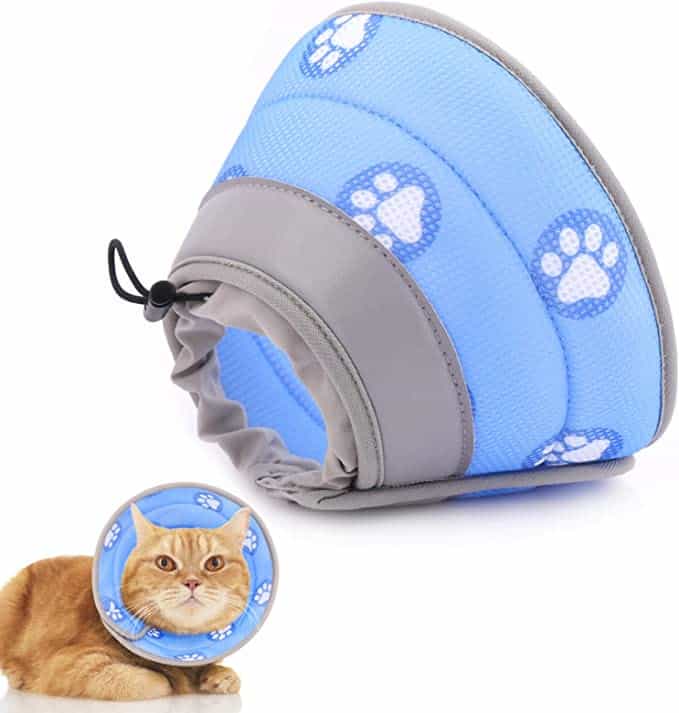
Soft Protective Collars: These collars are designed to protect a specific part of the cat’s body, such as the neck or shoulders. Rather than being cone-shaped and extending out in front of the cat’s head, these soft fabric collars jut out in a ring-shape around the cat’s neck. The cats can still lick some areas of their body, such as their feet, however, they cannot reach places such as their shoulders and chest.
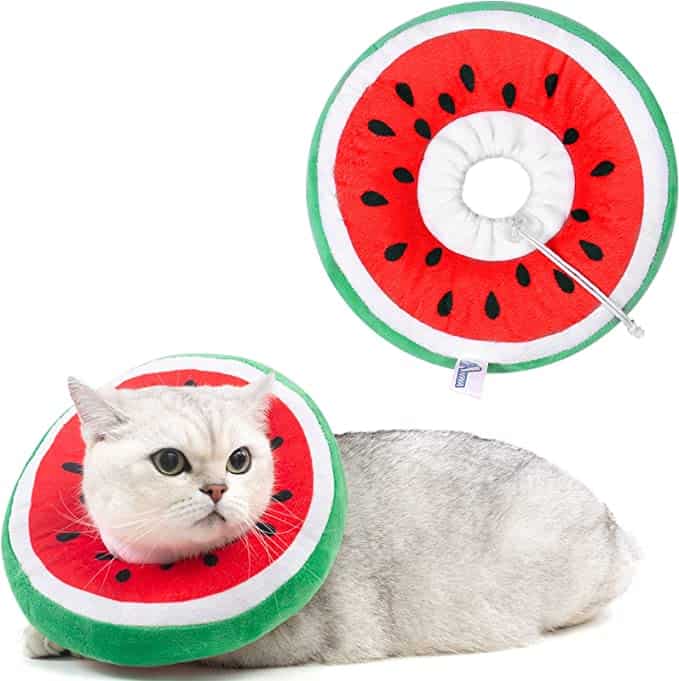
Inflatable Protective Collars: Inflatable protective collars for cats are similar in shape to the soft protective collar described about. They also have the same limitation in that they are unlikely to prevent the cat being able to lick or bite their lower limbs or areas below the abdomen.
These collars are usually made of a durable, scratch proof, yet flexible material that can be inflated to a certain size to fit around the cat’s neck. The collar is secured with an adjustable strap or velcro, and when inflated, creates a barrier around the cat’s neck that prevents them from reaching the affected area.
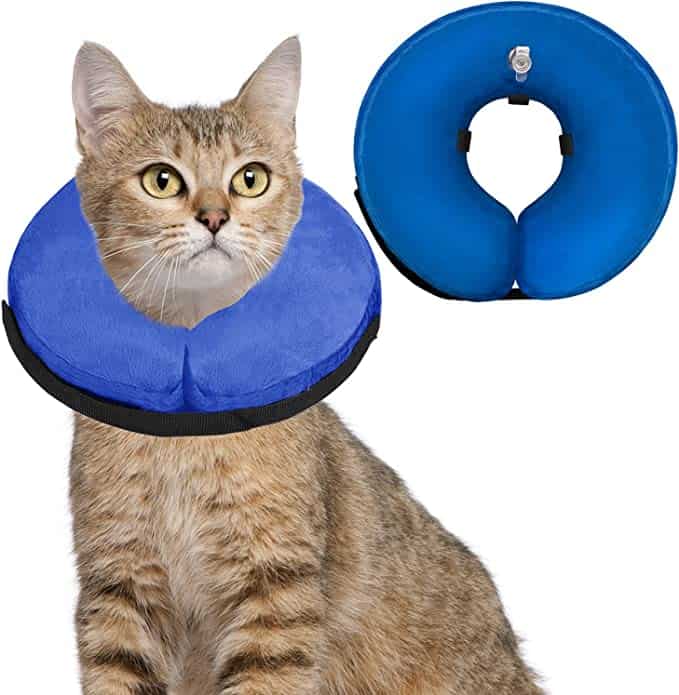
One advantage of soft or inflatable Elizabethan collars is that they are often more comfortable for cats to wear than traditional cone-shaped collars. They allow for more freedom of movement and are less bulky, which can make it easier for cats to eat, drink, and move around.
Does My Cat Need An Elizabethan Collar?
Cats may need an Elizabethan collar when they have a wound, injury, or surgical incision that needs to heal properly. This is because cats have a natural instinct to groom and clean themselves, but excessive licking or biting can damage the affected area and delay healing.
Additionally, if a cat has stitches or a wound, they may try to scratch it, which can cause further harm and increase the risk of infection.
Here are some specific scenarios where a cat may need an Elizabethan collar:
- After surgery: If your cat has had surgery, your veterinarian may recommend an Elizabethan collar to prevent them from licking or biting at the incision site. This can help the wound heal properly and reduce the risk of infection.
- Skin conditions: Cats with skin conditions such as allergies, rashes, or hot spots may excessively lick or bite at affected areas, causing further irritation or infection. An Elizabethan collar can prevent them from further damaging the skin and allow it to heal properly.
- Wound or injury: If your cat has a wound or injury, an Elizabethan collar can prevent them from scratching or biting at the area and allow it to heal properly. This is especially important for deep wounds or injuries that require stitches or other medical treatment.
Are There Alternatives To Elizabethan Collars For Cats?
Elizabethan collars can be uncomfortable for some cats and may limit their ability to eat, drink, and move around. Fortunately, there are are a couple of alternatives to Elizabethan collars for cats that can be more comfortable and effective in certain situations.
Cat Surgery Recovery Shirt Or Suit
One alternative is a recovery shirt or suit. Recovery shirts and suits are designed to cover a cat’s entire body and prevent them from accessing wounds or injuries. They are made of soft, breathable fabric and are machine-washable for easy cleaning.
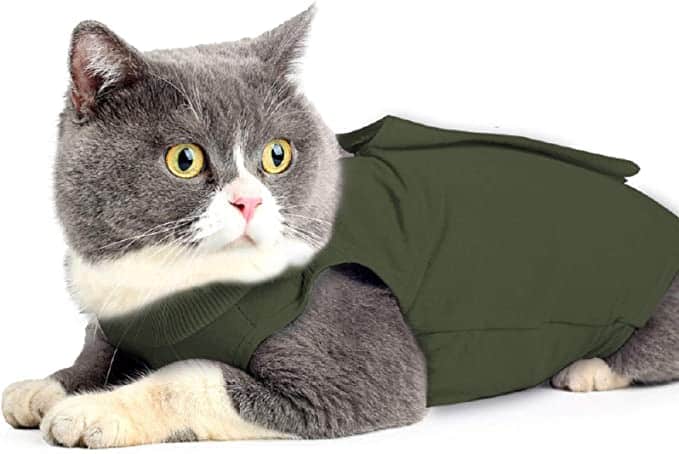
However, there are pro and cons to these garments:
Pros Of Cat Surgery Recovery Shirt Or Suits:
- Comfort: Recovery shirts and suits are typically made from soft, stretchy fabric that is comfortable for cats to wear. They can also provide warmth and support for the cat’s body during recovery.
- Convenience: Recovery shirts and suits are easy to put on and take off, making it simple to check on the cat’s wounds or administer medication as needed.
- Versatility: Recovery shirts and suits can be used for a variety of surgical procedures and injuries, including spaying and neutering, skin conditions, and minor injuries.
- Effective: These garments provide a physical barrier that prevents the cat from licking or biting at their wounds, which can help promote healing and prevent infection.
- Does not interfere with ability to eat and drink: Since the cat’s head is free and unencumbered, cats are still easily able to reach their food and water dishes whereas the Elizabethan collars get in the way of this.
Cons Of Cat Surgery Recovery Shirt Or Suits:
- Cost: Cat surgery recovery shirts or suits can be more expensive than other alternatives such as Elizabethan collars or neck collars.
- Fit: It’s important to make sure the recovery shirt or suit fits properly to ensure it’s effective in preventing the cat from accessing their wounds. Improperly fitting garments can be uncomfortable or even dangerous for the cat.
- Cleaning: Recovery shirts and suits need to be washed regularly to prevent the buildup of bacteria or odors, which can be time-consuming and require special care.
- Limited mobility: Recovery shirts and suits may limit the cat’s mobility to some extent, which can be a concern for more active cats or those with certain medical conditions.
- Cats may not tolerate them: Some cats may not tolerate a recovery shirt or suit and could become stressed, anxious, or even aggressive with it on. I’ve often seen cats just fall over and refuse to move, even after several days.
- Cats can still reach some areas: These suits cover the chest, torso and abdomen of the the cat but do not prevent access to the feet, legs and tail.
I purchased one of these myself very recently, to use when my Bengal cat gets her spay in a few weeks. My plan is to get her accustomed to wearing it before her surgery, so as to try to minimize any additional stress while she recovers.
Anti-Lick Products
Another option is anti-lick strips, sprays and ointments. Anti-lick strips are small adhesive strips that can be placed on a cat’s skin to discourage them from licking or biting at a particular area. Sprays and ointments work the same way, they are just different methods of application.
These products are designed to discourage pets from licking, biting, or chewing on their skin, fur, or wounds. They work by creating a deterrent that has a bitter or unpleasant taste.
Anti-lick strips are small adhesive strips that can be applied to the skin or fur in the area where the pet is likely to lick or chew. When the pet tries to lick or chew the area, they will be deterred by the bitter taste of the strip, which can prevent them from causing further irritation or damage to the skin. These are more often used for dogs than for cats.
Anti-lick sprays, on the other hand, are liquid sprays that can be applied directly to the skin, fur, or bandage. They also contain ingredients that have a bitter taste or unpleasant odor, which can discourage the pet from licking or biting the area. Some anti-lick sprays also contain natural ingredients that can soothe and heal the skin, such as aloe vera.
Both anti-lick strips and sprays can be effective in preventing pets from licking or biting at areas that need to heal, such as wounds or surgical incisions. However, it’s important to note that these products are not a substitute for proper medical care and should only be used under the guidance of a veterinarian.
Anti-lick products don’t work for all cats – or dogs. I once had a dog that that actually LIKED the taste of it! She would eagerly lick the spray off of her paws and practically ask for more!
Pets may also get used to the taste or smell of anti-lick products over time, so it’s important to monitor your pet’s behavior and remove the product if it’s not effective.
Finally, many anti-lick products are not intended for use directly on the wound but instead are meant to be applied on top of a bandage to keep the cat from tearing it off, or on the fur and skin around the wound. Never apply an anti-lick product directly on a rash or wound unless directed by your veterinarian.
It’s important to note that not all alternatives to Elizabethan collars are suitable for all situations. Your veterinarian can help you determine which type of protective device is best for your cat based on their specific needs and condition.
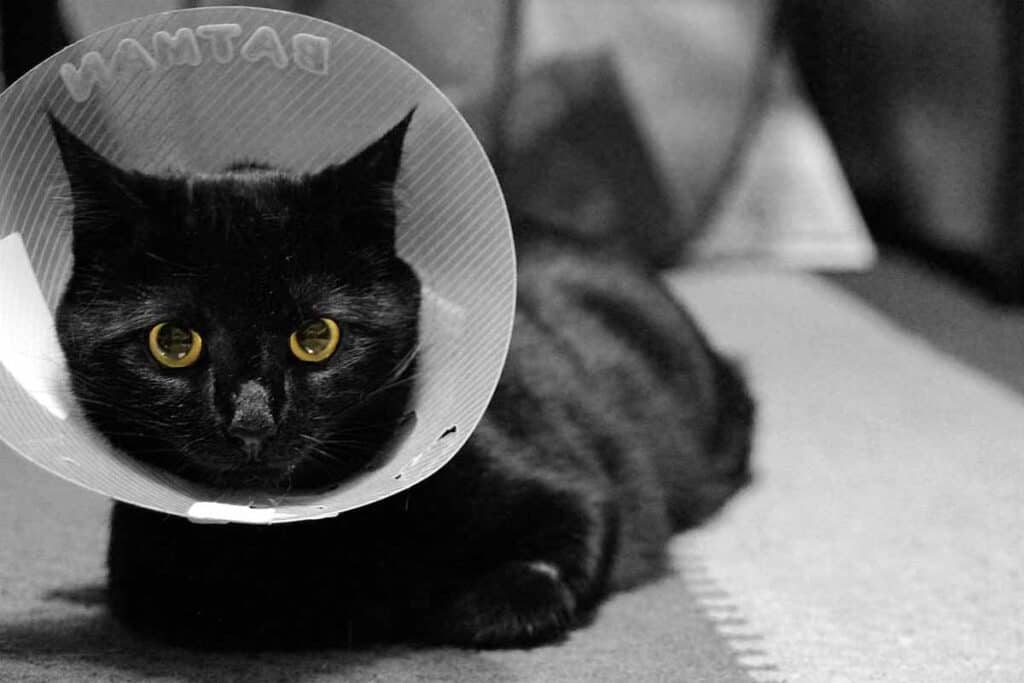
Homemade Elizabethan Collars For Cats
Homemade Elizabethan collars are a great option when you need a collar in a hurry and don’t have access to a ready-made one. They can also be useful as an inexpensive option for seeing how your cat tolerates an Elizabethan collar before going out and spending money on one.
These DIY collars use materials like cardboard or foam core boards, which can be shaped into the desired size and shape to fit around your cat’s neck. They are quick and easy to make, often just using materials you already have around your home.
However, it’s important to note that homemade collars may not provide the same level of protection as ready-made ones. Collars made of paper or foam can be damaged and removed fairly easily if the cat is determined enough. They are also more likely to come off or move around on the cat, making them less effective in preventing your cat from grooming, scratching, or biting at an area that needs to heal.
Sturdier DIY Elizabethan collars can be made from sturdy yet flexible plastic if you happen to have such material on hand. However, the edges of the collar made from this material can be sharp or jagged and should be cushioned with foam or fabric.
Design the collar to fit around your cat’s neck without the use of strings or ties, which can be dangerous to the cat. You’ll also need to make sure that the collar is not too tight and allows enough room for your cat to breathe and swallow.
I could try to explain here how to make your own DIY Elizabethan collar, but as the saying goes – a picture is worth a thousand words! I refer you to the video below for a very easy method to make your own Elizabethan collar for your cat:
Just remember, homemade Elizabethan collars are a great option in a pinch, but they may not provide as much protection as a traditional Elizabethan collar. So it’s still important for you to monitor your cat closely and check the collar often.
What Is The Best Elizabethan Collar For Cats?
When it comes to choosing the best Elizabethan collar for cats, there is no one-size-fits-all solution. The best collar for your cat will depend on several factors, including their medical condition, temperament, and ability to tolerate the collar. Here are some considerations to keep in mind when choosing the best Elizabethan collar for your cat:
Medical condition: The type of Elizabethan collar you choose will depend on your cat’s specific condition. For example, a cat recovering from surgery may need a sturdier, more rigid collar, while a cat with a minor injury may do well with a softer, more flexible collar.
Temperament: Some cats may be more sensitive or easily stressed by the collar, while others may adjust to it quickly. Consider your cat’s temperament when choosing a collar and opt for a design that will minimize stress and discomfort.
Tolerance: Some cats may simply refuse to wear an Elizabethan collar, no matter how well-designed or comfortable it is. In these cases, alternative solutions such as anti-lick products or recovery suits may be a better option.
Cost: Elizabethan collars can vary in price, so consider your budget when choosing a collar. While more expensive collars may offer additional features or be made from higher-quality materials, there are also affordable options available that may work just as well for your cat’s needs.
In general, the best Elizabethan collar for your cat is one that provides the necessary level of protection while minimizing stress and discomfort. Ultimately, the decision will depend on your cat’s individual needs and preferences. Consulting with your veterinarian can also be helpful in determining the best type of collar for your cat’s specific condition and recovery needs.
Summary
In summary, an Elizabethan collar is a cone-shaped device that is used to prevent cats from licking or scratching wounds or injuries, or to prevent them from interfering with post-surgery healing.
When selecting an Elizabethan collar for a cat, there are several factors to consider, including the cat’s specific condition, temperament, tolerance, and budget. Some alternatives to Elizabethan collars for cats include anti-lick strips, sprays, and recovery suits.
Ultimately, the best collar for a cat will depend on its individual needs and preferences, and consulting with a veterinarian can help determine the most appropriate option for your cat.
Disclaimer: This article is intended for information purposes only, and does not constitute medical advice. Always consult your veterinarian if you have specific concerns about your pet’s health.
